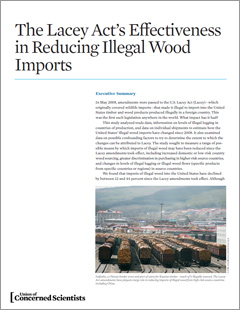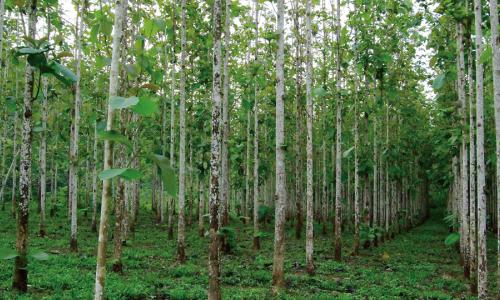Deforestation due to illegal logging is a serious problem in many timber-producing countries around the world. It has devastating effects on the environment and on people who depend on forests for their livelihoods. It robs cash-strapped governments of valuable revenues, fosters corruption, and in some cases helps fuel violent conflict. And illegal logging is also a major contributor to climate change.
In May 2008, amendments were passed to the U.S. Lacey Act—which originally covered wildlife imports—that made it illegal to import into the United States timber and wood products produced illegally in a foreign country. This was the first such legislation anywhere in the world. What impact has it had? Our 2015 report, The Lacey Act's Effectiveness in Reducing Illegal Wood Imports, seeks to answer that question.
The study analyzed trade data, information on levels of illegal logging in countries of production, and data on individual shipments to estimate how the United States’ illegal wood imports have changed since 2008. It also examined data on possible confounding factors to try to determine the extent to which the changes can be attributed to Lacey.
The study sought to measure a range of possible means by which imports of illegal wood may have been reduced since the Lacey amendments took effect, including increased domestic or low-risk country wood sourcing, greater discrimination in purchasing in higher-risk source countries, and changes in levels of illegal logging or illegal wood flows (specific products from specific countries or regions) in source countries.
Progress, not perfection
Imports of illegal wood into the United States have declined by between 32 and 44 percent since the Lacey amendments took effect. Although other factors have been important, Lacey has clearly contributed to this reduction. However, Lacey has not prevented all imports of illegally sourced wood products. In 2013 these were estimated to have been worth $2.8 billion.
The study also found an overall decline since 2007 in the proportion of U.S. consumption of major wood products supplied by imports (with Lacey likely a contributing factor only for hardwood plywood). However, the proportion of U.S. wood imports originating in countries at high risk of illegal logging has actually increased, from 19 to 27 percent, because imports from low-risk countries were more greatly affected by the contraction in housing construction.
Focus on China
Since China was estimated (prior to the Lacey amendments) to supply around two-thirds of U.S. imports of illegally sourced wood products, the report focuses significant attention on that country. The proportion of China’s imports of logs and sawn wood originating in high-risk countries has declined dramatically—from 80 percent in 2007 to 45 percent in 2013. This constitutes a major factor behind the substantial decline in the amount of illegal wood in Chinese exports to the United States.
Shifts in U.S. purchasing, likely due in part to Lacey, have also served to reduce estimated illegal imports from China. U.S. imports of tropical plywood from China, for instance, have fallen by 90 percent.
Detailed examination of specific high-risk products from specific countries provides additional evidence that Lacey has made a difference. For example, most imports of paper from Indonesia now have legality verification and come from plantations rather than natural forests.
The trade data analyzed in the report indicate that the Lacey Act amendments have contributed to reducing U.S. imports of illegal wood products. To promote further progress, the report recommends strengthening enforcement of the Lacey Act, focusing on countries and products for which substantial illegality remains.
Conclusions and recommendations
The report's findings show a substantial decline in illegally sourced imports into the United States since the Lacey amendments took effect. While it's impossible to say precisely what part Lacey played in this decline—other effects were also important—the available evidence suggests that Lacey did play a role. Its impact has been mostly due to U.S. buyers avoiding high-risk products or high-risk countries, rather than trying to discriminate between legal and illegal wood in like products.
However, the results also show that large volumes of wood continue to be imported into the United States from likely illegal sources, despite this being illegal under the Lacey amendments. It is likely that better enforcement of Lacey could reduce these imports much further. Such enforcement should be focused on the wood flows from the highest-risk countries, such as China, Indonesia, and Vietnam. Stronger enforcement efforts can help continue the progress made so far and assure American consumers that their imported wood products come from legal sources.






